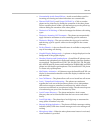
Administrator’s Guide SoundPoint IP / SoundStation IP
3 - 2
Setting Up the Network
Regardless of whether or not you will be installing a centrally provisioned
system, you must perform basic TCP/IP network setup, such as IP address
and subnet mask configuration, to get your organization’s phones up and
running.
The bootROM application uses the network to query the boot server for
upgrades, which is an optional process that will happen automatically when
properly deployed. For more information on the basic network settings, refer
to DHCP or Manual TCP/IP Setup on page 3-2.
The bootROM on the phone performs the provisioning functions of
downloading the bootROM, the <Ethernet address>.cfg file, and the SIP
application, and uploading log files. For more information, refer to Supported
Provisioning Protocols on page 3-4.
Basic network settings can be changed during bootROM download using the
bootROM’s setup menu. A similar menu system is present in the application
for changing the same network parameters. For more information, refer to
Modifying the Network Configuration on page 3-5.
DHCP or Manual TCP/IP Setup
Basic network settings can be derived from DHCP, or entered manually using
the phone’s LCD-based user interface, or downloaded from configuration
files.
The following table shows the manually entered networking parameters that
may be overridden by parameters obtained from a DHCP server, an alternate
DHCP server, or configuration file:
Polycom recommends using DHCP where possible to eliminate repetitive manual
data entry.
Parameter DHCP Option DHCP
Alternate
DHCP
Configuration File
(application only)
Local
FLASH
D priority when more than one source exists D
12 3 4
IP address 1•-- •
subnet mask 1•-- •
IP gateway 3•-- •


















